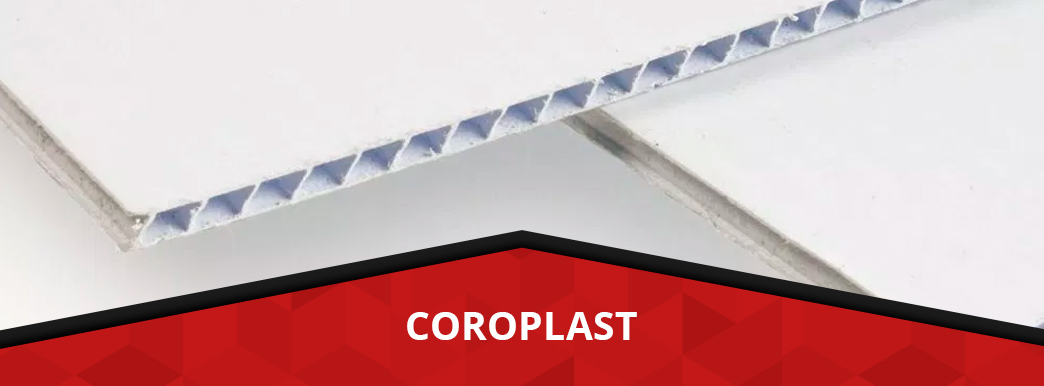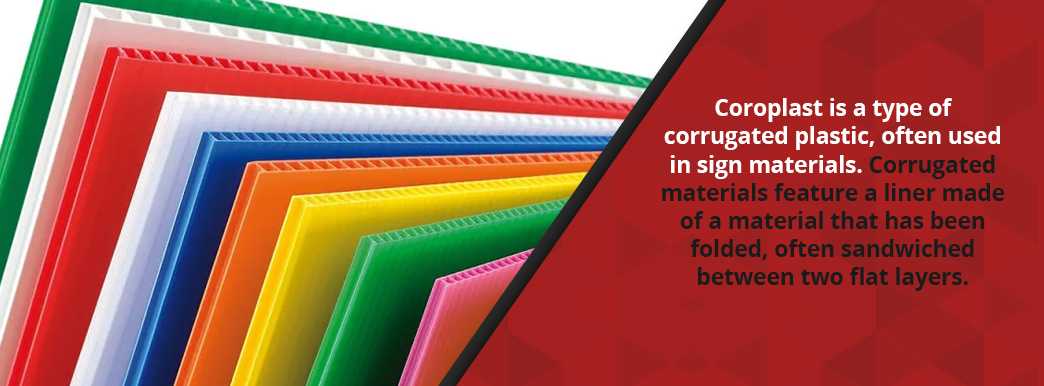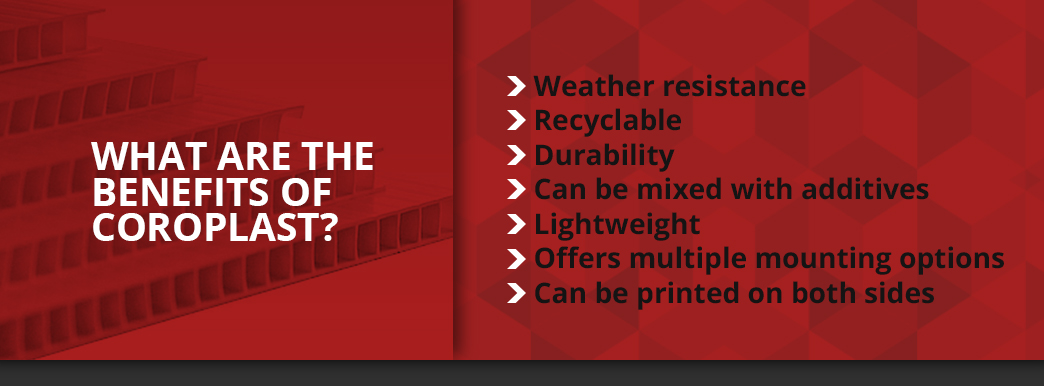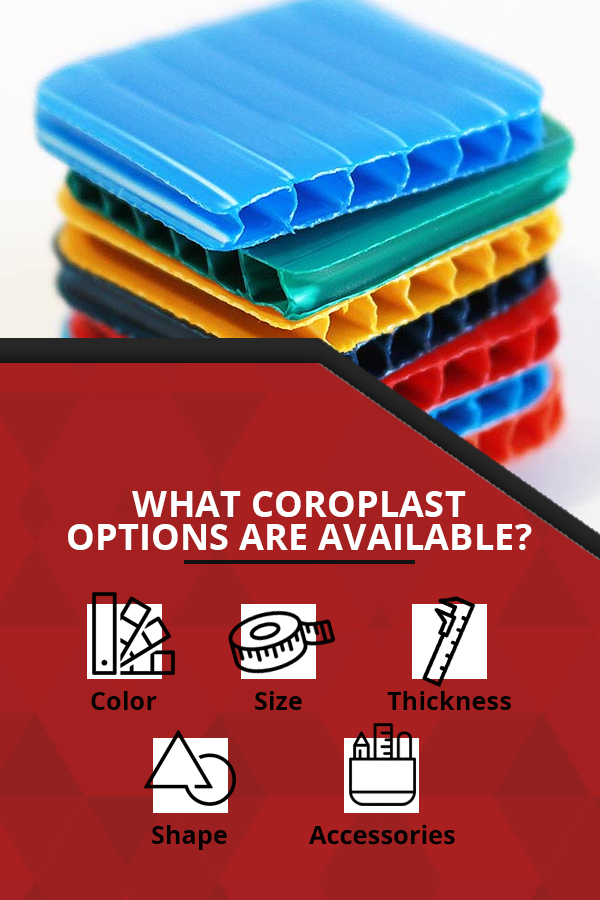If you want signage, whether, for outdoor or indoor use, you need to consider the sign’s material. Signs can be printed on a variety of materials, from metal to plywood and from foam board to plastic. Each type of material has its benefits and drawbacks, and some materials might be better suited for certain conditions than others.
One option you might consider when picking out the material to use for your signage is Coroplast. Learn more about the benefits of Coroplast, its construction, and its usage options to see if it’s a good pick for your next sign.
WHAT IS COROPLAST?
Coroplast is a type of corrugated plastic, often used in sign materials. Corrugated materials feature a liner made of a material that has been folded, often sandwiched between two flat layers. The inner layer of coroplast is made up of a series of ridges and furrows, which help to strengthen and reinforce it. Because of its design and appearance, coroplast is sometimes called “plastic cardboard.”
The word coroplast is a brand name for a product first developed in the 1970s. Although there are other brands of corrugated plastic available, the name coroplast is often used generically to refer to any corrugated plastic, similar to the way people say they will Xerox something rather than photocopy it, or ask for a Kleenex instead of a tissue.
WHAT ARE THE USES FOR COROPLAST?
You can use coroplast in many different applications. Even if you weren’t familiar with the name previously, you likely encounter coroplast in your daily life. Some common uses for the material include:
- Lawn signs: Yard or lawn signs advertising a candidate running for office or an open house are occasionally made from coroplast.
- Billboards: Many billboards are made of coroplast, thanks to its weather resistance.
- Food packaging: Coroplast is often used for packaging fruits and vegetables from farmers.
- Boxes and crates: Storage containers and packages designed for transporting items are often made of coroplast. You’ve probably seen mail carriers carting around coroplast boxes full of mail and packages.
- Dividers: The dividers that separate items in packages are often made of coroplast.
- Industrial use: Coroplast also has some industrial applications, such as providing the foundation for temporary walls and partitions.
FAMOUS USES OF COROPLAST
Coroplast played a supporting role in some significant events in the 1970s, shortly after its introduction. It was the primary material used to produce the signs that announced the name change of Esso and Humble Oil to Exxon. Many of the signs used to promote the Olympic Games in Montreal in 1976 were made of coroplast, as well.
WHAT ARE THE BENEFITS OF COROPLAST?
Why choose coroplast over different types of material for your signage? The plastic material offers multiple benefits.
- Weather resistance: Coroplast won’t get soggy in the rain, it won’t melt in the heat and it won’t become brittle or frail in the cold. You can use the material both inside and outside without any issues.
- Recyclable: Coroplast is often made of polypropylene, or #5 plastic, which a lot of communities recycle. Recycling coroplast allows it to enjoy a second life as a broom, a brush, a bike rack or a plastic funnel.
- Durability: Along with being weather-resistant, coroplast is very durable. It won’t break down or tear easily. Signs and other products made from the material can be used over and over again for many years.
- Can be mixed with additives: In the production process, coroplast can be combined with specific additives to make it even more resistant and durable. For example, additives can be added to the plastic to boost its UV resistance or to make it flame retardant.
- Lightweight: Coroplast is very lightweight, which means it’s easy to transport. Its weight also helps to reduce the cost of shipping the material.
- Offers multiple mounting options: If you are going to use coroplast for signage, you have various options for hanging the sign. You can choose coroplast signs with grommets so that you can hang them from a wall or a hook. If you are interested in coroplast yard signs, you can attach a stake to the bottom to push the sign into the ground.
- Can be printed on both sides: The structure of coroplast means that you can print a message on one or both sides of the sign.
HOW DOES COROPLAST COMPARE TO OTHER SIGN MATERIALS?
Coroplast isn’t your only option when it comes to materials for signage. Other popular sign materials include:
- Acrylic
- Aluminum
- Foam board
- Vinyl
- Wood
Each option has its own set of advantages and disadvantages. For example, like coroplast, foam board tends to be very lightweight. Since it is made of a type of paper, though, it’s best suited for indoor use only. It won’t withstand outdoor conditions, such as high humidity or rain.
Aluminum is also relatively lightweight and durable and can be used outdoors. It has a considerably higher price point than coroplast, though, meaning it might not be the right choice for everyone.
Vinyl signs might be appropriate for outdoor use, for short periods. If you are looking for a sign to use outside all the time, you are better off choosing coroplast.
Another thing to consider when thinking about materials for signs is the shape of the sign you want. While you can cut coroplast into different shapes, if you are interested in contour cut signage, you might get better results with a different material.
WHAT COROPLAST OPTIONS ARE AVAILABLE?
Whether you’re looking for small printed signs to give to people to put on their lawns or are looking to print one large sign to use outside, coroplast is available in a range of sizes, shapes, colors, and thicknesses. Learn more about your coroplast options.
COLOR
Coroplast is available in a rainbow of colors. You can choose basic white or black, or choose a more vibrant hue, such as blue, red, or yellow. In addition to the material itself being available in a variety of colors, you also have the option of printing on coroplast signs in full color.
SIZE
Coroplast comes in a variety of sizes. You can order signs that are about the size of a standard sheet of paper, 10 inches by 12 inches. You can also order poster-sized coroplast signs, which measure 24 inches by 36 inches.
Are you looking for something a little bigger? No worries. A single sheet of coroplast can often measure up to 4 feet by 8 feet. Larger sizes are available, as well. No matter how big or small your sign needs to be, the professionals at SpeedPro can accommodate you.
THICKNESS
The thickness of printed coroplast signs influences durability. You have many options when it comes to thickness. If you’re looking for a particularly sturdy sign, you can choose a coroplast that’s 10 mm thick.
If you aren’t concerned about the sign bending or breaking, you can select a thinner size, such as 4 mm.
SHAPE
Common shapes for coroplast signs include squares and rectangles. But you aren’t limited to four-sided shapes. Some die cut or custom cut options are available. For example, if you plan on hiring a sign spinner to perform tricks and attract people to your store or booth, you can order a coroplast sign cut into the shape of an arrow. If you have an idea for a shape and aren’t sure if it will work or not, we’ll happily help you out.
ACCESSORIES
Depending on the size of your coroplast sign, you might want to use some accessories with it to help it stand up or to hang it.
One option is to have grommets placed in the sign, either in the four corners or all along the sides. You can thread a rope or piece of string through the grommets to hang the sign from a wall or ceiling.
Smaller signs, such as those used on a lawn or yard, can be fitted with an H-stake or another wire frame, which will allow you to push the sign into the ground. You can also consider ordering an a-frame to support your coroplast sign.
ARE THERE DRAWBACKS TO COROPLAST?
Although coroplast can be the perfect option for many indoor and outdoor signs, it’s not perfect and it won’t work for everyone. One thing to know about coroplast is that it’s challenging to glue items to it. For example, if you were interested in gluing two coroplast signs together, back to back, the construction of the plastic would prevent the signs from sticking together.
While you can’t glue two pieces of coroplast together, you do have the option of printing on both sides if you want a double-sided sign.
It’s also worth noting the challenge of painting on coroplast. If you have a blank piece of coroplast, the best way to paint it is with spray paint designed for use on plastics. Paint that you apply with a brush or roller is likely to peel off of the plastic.
Another drawback of coroplast is that some people don’t like the way it looks. Since it is a plastic material, it’s not nearly as sophisticated looking as other sign options, such as aluminum or glass. While it might not look as elegant as those options, it is considerably less expensive.
WHERE CAN YOU USE COROPLAST SIGNS?
With their long life, weather resistance and other benefits, coroplast signs can be used in many different places. If you’re looking for some inspiration, here are a few common places where you can put a coroplast sign to good use.
- At a trade show: You can incorporate coroplast signs into your trade show display to help people learn more about your brand or to catch people’s eye as they pass by your booth. Since you can use coroplast indoors or out, you can use your signs for all types of trade shows and other marketing events.
- On a lawn to advertise an open house: One common use for coroplast signs is to advertise homes for sale. You can push a sign into a yard to promote an open house or hang a sign from a porch to announce that the property is for sale.
- In a store: You can use coroplast signs for advertising a sale or for directing people to the checkout counter or changing rooms. Since the signs are so durable, you can reuse them year after year to promote annual sales or other special events.
- Outside of a restaurant: You can place an a-frame coroplast sign outside of a restaurant or cafe to advertise a regular special, such as happy hour or an early bird dinner special. When the hours of the special pass, you can bring the sign back in. You can also use coroplast signs for advertising short-term specials, such as a seasonal dish or a creative cocktail you offer.
- At a political event: If you’re working on a campaign or trying to get a politician elected, you can use coroplast signs to promote your candidate and encourage people to learn more about them.
- At a concert or festival: Coroplast signs can help people find their seats, the merchandise table, or the restroom at a concert or outdoor musical festival.
HOW TO CARE FOR COROPLAST
Although you can use coroplast signs for a single event, then recycle them, it’s also possible to reuse your signs years after year and event after event. When used indoors, coroplast can have a lifespan of more than 10 years. Taking good care of your coroplast signs will help to prolong their life.
One way to care for your signs is to give them a good cleaning now and then, especially if you use the signs outside. You don’t need special equipment or cleaning supplies. All you need is some gentle soap, a bit of warm water, and a washcloth or soft-bristled brush. When cleaning your signs, try to wipe them in the direction of the corrugation.
Another part of taking good care of your coroplast signage is storing it properly when it’s not in use. For best results, keep the sign flat when it’s in storage. It’s better to store the signs upright, rather than flat on a shelf or the floor. Try to avoid putting items, such as boxes, on top of the signs when they’re in storage.
If possible, keep your signs out of direct sunlight when stored. The sun’s UV rays can cause the signs to fade or weaken the plastic.
One final note about storage — if you can, don’t try to roll or fold the signs. Doing so can lead to creases and make it challenging for the signs to lie flat when it’s time to use them again.




